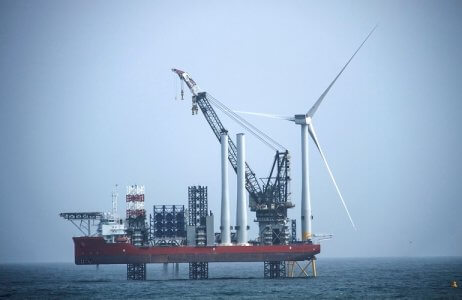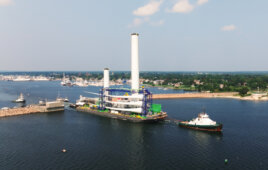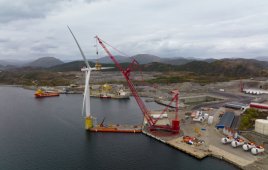By Jordan Freed, Director of Corporate Marketing & Product Strategy, Gastops
There is an abundance of literature dating back over the past 20+ years about the challenge of premature gearbox failures, and the cost impact they have on wind turbine operation. While the principals of prognostics and health management (PHM) are well established, and the objective of replacing unplanned failure events with scheduled maintenance based on early indication of degradation has not changed, the wind industry and sensor technology continue to evolve in ways that steadily increase the value proposition.
With global acceptance of the need to shift our energy dependence to renewables, the demand for wind energy is driving the development of much larger turbines and a significant increase in offshore wind farms. The primary cost avoidance targets associated with PHM, or condition based maintenance (CBM) are tied to business interruptions, inspection and repair costs, along with downtime penalties. The larger the turbine, the more difficult to reach, the higher the cost and complexity associated with inspection and maintenance. Secondary or catastrophic failure events that cannot be addressed in-situ are even more concerning with taller, harder to reach and heavier components. Further, with greater dependency on wind as a primary energy source, the cost of downtime penalties is also likely to continue increasing.

Evolution of wind turbine size and output. Source: Liebreich
Wind turbine heights and rotor diameters have easily doubled since the early 2000s as the industry pushes the boundaries of production per turbine. With the emergence of offshore wind as a major source of energy, size will continue to increase the maintenance challenge. In 2019, General Electric installed the Haliade-X turbine prototype in the Port of Rotterdam. The wind turbine stands 260 m (853 ft) tall and has a rotor diameter of 220 m (721 ft). Vestas plans to install the V236-15MW offshore prototype at Østerild National test centre for large wind turbines in Western Jutland, Denmark, in the second half of 2022. The wind turbine is 280 m (918 ft) tall with a predicted production output of 80 GWh a year, enough to power nearly 20,000 households. The criticality of keeping the massive wind turbines of the future running and being able to efficiently maintain them based on condition will only increase in importance.
While wind turbine, gearbox and bearing manufacturers strive to design more reliable assets, the common phenomenon limiting useful life continues to be surface fatigue resulting from repeated stresses under bearing rolling contact or gear meshing contact. Excessive loads, misalignment, material flaws, manufacturing defects, mishandling, contaminants in the oil, high oil temperatures and corrosion are some of the potential contributors to localized damage that begin to degrade the bearing or gear. In other words, the reality is that even with more reliable bearings and gearboxes, there will always be a probability of failure over time supporting the value proposition of moving from reactive to proactive, condition-based and ultimately to predictive maintenance.
That desired future state of truly predictive maintenance is well articulated in the principal of “Maintenance 4.0” that is the application of “Industry 4.0” technologies (industrial analytics, automation, robotics, etc.) to operations and maintenance (O&M) activities. The business objective is to radically improve equipment availability while lowering O&M costs through digitalization. While much attention is paid to the advances in artificial intelligence as means to turn data into valuable insights, the often unspoken challenge is that insights are only as good as the data.
In the case of wind turbines, that data comes from sensors used to monitor the health of the bearings and gearboxes. Progressing toward predictive maintenance requires the ability to not just identify damage, but to determine damage severity and calculate time to failure or remaining useful life (RUL). This is where oil debris monitoring differentiates itself from other types of sensors, as quantifying the wear debris from a damaged component is a direct representation of the damage of the monitored component.
For wind turbine gearboxes, oil debris monitoring (ODM) technology provides an early indication of bearing spall and gear pitting damage and quantifies the severity of damage progression towards failure. Online oil debris monitoring provides the most reliable and timely indication of bearing degradation because:
- Bearing failures on rotating machines tend to occur as events and could be missed by means of only periodic inspections or data sampling observations.
- As large wear particles are being detected by the oil debris monitoring sensor, there is a low probability of false indication from benign smaller wear debris particles.
- Residual or wear-in debris can be differentiated from the actual damage debris because the accumulated particle counts recorded due to the former tend to decrease while those due to the latter tend to increase.
While ODM technology itself is a proven technology used in asset management across multiple industries, truly understanding the physics of failure to be able to develop the algorithms necessary to accurately predict RUL requires years of study. Ottawa, Canada-based Gastops first started conducting surface fatigue tests on bearings to understand the progression of failure in 1992, bringing ODM to the wind market in the early 2000s.
The company is now a world leader in critical equipment condition monitoring, having installed over 20,000 oil debris monitoring sensors on active wind turbines with a proven history of detecting early signs of damage in advance of failures, maximizing availability while minimizing downtime and maintenance costs. Realizing the goals of PHM, the technology is used to monitor drivetrain health, by detecting the initiation of damage and monitoring its progression, which enables maintenance events to be scheduled proactively, preventing costly unplanned downtime during critical operating periods.
The ability to determine the remaining useful life of an asset is critically important as it provides the necessary information for operators to optimize the operational lives of their gearbox and main bearing. The company’s flagship product, MetalSCAN, is an online advanced oil debris sensing technology which is plumbed into the return oil line from the gearbox or main bearing. Any debris generated within the gearbox passes through its core and is quantified in terms of size, frequency and the type of metal, whether it is ferrous or non-ferrous material.
This information is collected and compared against predefined warning and alarm limits, developed using customized algorithms based on the geometry of the gearbox. When debris passes through the sensor, MetalSCAN translates the information it gathers into the RUL of the gearbox or main bearing. This allows the operator to understand the current health, adjust operational parameters and plan maintenance activities, preventing the requirement for shutdown during critical operation periods.
 While ODM provides an ideal data source to provide the valuable insights required to support predictive analytics, realizing the vision, and leveraging the potential of Maintenance 4.0 will require a variety of data sources in multiple locations to improve the accuracy of modeling, allowing operators to pinpoint failures throughout the system. Many wind turbine manufacturers already combine vibration sensors and ODM into the overall condition monitoring systems they provide.
While ODM provides an ideal data source to provide the valuable insights required to support predictive analytics, realizing the vision, and leveraging the potential of Maintenance 4.0 will require a variety of data sources in multiple locations to improve the accuracy of modeling, allowing operators to pinpoint failures throughout the system. Many wind turbine manufacturers already combine vibration sensors and ODM into the overall condition monitoring systems they provide.
As technology advances to enable the transition from condition-based maintenance to truly predictive maintenance, real-time equipment intelligence will be required. Systems that combine the information from next generation real-time sensors that monitor data on multiple factors such as oil debris, oil condition, vibration, temperature and pressure will be used to develop advanced analytics and digital twins. Connectivity to enable large scale IIOT deployments with the assurance of data security and network reliability will be key factors in enabling wind farm operators of the future to realize the vision of Maintenance 4.0.
Paramount to success in this evolution remains the intersection of machine intelligence with human ingenuity. The expertise that comes with decades of research into the physics of failure by a company like Gastops combined with a commitment to innovation and drive to realize the vision of real-time prognostics will lead to a future of optimized O&M costs in the wind industry. Today’s ODM technology is already providing the benefits of PHM envisioned 20 years ago. The rapidly increasing demand for wind energy is driving the creation of massive wind turbines that are being located offshore. There is a clear requirement to evolve condition monitoring systems to provide operators with PHM capability enabling the future of predictive maintenance.
 Jordan Freed is the Director of Corporate Marketing & Product Strategy for Gastops Ltd, where he is responsible for product management, strategic growth and marketing. With a Bachelor’s Degree in Electrical Engineering and over 25-years of experience, Jordan is a customer focused leader, passionate about innovation and product realization to address the future needs of the market. His career spanned multiple industries including steel, telecom and defense prior to joining Gastops in 2020 to support the organization’s long term growth objectives.
Jordan Freed is the Director of Corporate Marketing & Product Strategy for Gastops Ltd, where he is responsible for product management, strategic growth and marketing. With a Bachelor’s Degree in Electrical Engineering and over 25-years of experience, Jordan is a customer focused leader, passionate about innovation and product realization to address the future needs of the market. His career spanned multiple industries including steel, telecom and defense prior to joining Gastops in 2020 to support the organization’s long term growth objectives.
Filed Under: Featured, Gearboxes, Lubricants






Great topics I am able to read and get to know knowledge on the different topics on wind turbine generator topics. Need more topics on vibration analysis part topics like How to detect Gear failures in planetary stage and Main bearing failures by using FFT and TWF.